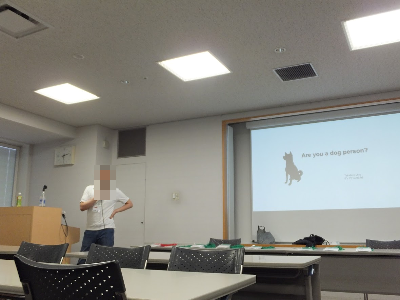

:::::::::::::::::::::::::::::::::::::::::::::::::::::::::::::::::::::::::::::::::
《 今回のworkshop 》
○workshop参加人数:50名(うち新人の方:3名)
○【前半】: Are you a dog person?
○【後半】:Mythology
:::::::::::::::::::::::::::::::::::::::::::::::::::::::::::::::::::::::::::::::::
【前半】
Title:
Are you a dog person?
Introduction:
Do you like dogs or perhaps are you a cat enthusiast? If you’re an animal lover, I’m positive that this time’s session would definitely be of much fun! Let’s share with us your story about your four-leg friend! And secondly, we’ll delve into our history with them, the very beginning of our relationship, here especially, with dogs.
Not like any other four paws, the dog is often considered a man’s partner. In times where there was no shortage of hunters, they took dogs to hunting so that they could retrieve game they took down. Those dogs are called Retriever. In 18th century England, there was a blood sport Bull-baiting where people make a bull fight another animal, commonly a dog (outlawed in 1835). This valiant dog is now called Bulldog. So, it’s not hard to guess the partnership between humans and dogs has a long history, is it? And in fact, it does, presumably way longer than you expect.
70,000 years ago, Big Bang occurred to the human brain. Human kind suddenly awakened to the ability to transmit information about things that do not really exist, such as tribal spirits, nations and liabilities, say, the advent of religious beliefs – the Cognitive Revolution. It allowed Homo Sapiens to make a bigger and more cohesive group than other creatures could and with such strength in numbers, they started to spread from Africa hunting and foraging. This lifestyle changed 12,000 years ago. They began to spend their time manipulating the lives of a few animals and plants. They thought it would be the stable source of calories they need – the Agricultural Revolution. As domestication of animals started, they became members of a human community but this doesn’t mean that they were equal to their masters.
There is just one exception there, the dog. The dog was the first animal domesticated by mankind but it happened even before the Agricultural Revolution, 15,000 years ago (or more). Dogs were used for hunting and as an alarm system against intruders. With the passing of thousands of years, the two harmonious species co-evolved to communicate well with each other. Dogs attend to the needs of humans and humans feed them in return.
But here’s food for thought (not intended), why could no other species but the dog be a partner of human beings? What characterizes communication between humans and dogs? And ultimately, how do you define communication?
Discussion Questions:
(Introductory) What’s your favorite animal? Why do you like it?
Q1 Do you have a pet? Tell us your story with your pet, their specialty, weird habit, etc. If you are zoophobic, describe the reason why you became so.
Q2 When your pet tries to communicate with you, what would it do? And what’s the key to interpretation of its meaning? (see the link for reference, https://www.petcoach.co/article/10-ways-dogs-try-to-communicate-with-us/)
Q3 The dog is good at communication with humans, but why could only the dog be a partner of them you think? What characterizes communication between humans and dogs?
Q4 Now, how do you define communication?
【後半】
Title:
Travel: Extreme Adventure & Ghetto Tourism
Discussion questions:
Q1 What is the difference between touring and backpacking?
Q2 What form of traveling appeals to you and why?
Q3 Describe overcoming difficulties while traveling to unknown destinations.
Q4 Describe your wildest adventure, whether local or global.
Reference:
The movement of people between distant geographical locations. Travel can be done by foot, bicycle, automobile, train, boat, bus, airplane, ship or other means, with or without luggage, and can be a one way or round trip. Travel can also include relatively short stays between successive movements.
The origin of the word “travel” is most likely lost to history. The term “travel” may originate from the Old French word travail, which means ‘work’. The first known use of the word travel was in the 14th century. It also states that the word comes from Middle English travailen, travelen (which means to torment) and earlier from Old French travailler (which means to work strenuously)
In English we still occasionally use the words “travail”, which means struggle. The words “travel” and “travail” both share an even more ancient root: a Roman instrument of torture called the tripalium (in Latin it means “three stakes”, as in to impale). This link may reflect the extreme difficulty of travel in ancient times.
Today, travel may or may not be much easier depending upon the destination you choose (Mt. Everest or the Amazon rainforest), how you plan to get there (tour bus or cruise ship), and whether you decide to “rough it” (extreme tourism and adventure travel). There’s a big difference between simply being a tourist and being a world traveler. This is, however, a contested distinction as academic work on the cultures and sociology of travel has noted.
Extreme tourism is a niche in the tourism industry involving travel to dangerous places (mountains, jungles, deserts, caves, canyons, etc.) or participation in dangerous events. Extreme tourism shares the main attraction, “adrenaline rush” caused by an element of risk, and differing mostly in the degree of engagement and professionalism.
While traditional tourism requires significant investments in hotels, roads, etc., extreme tourism requires much less to jump-start. In addition to traditional travel-based tourism destinations, various exotic attractions are just as popular.
Adventure travel is a type of niche tourism, involving exploration or travel with a certain degree of risk (real or perceived), and which may require special skills and physical exertion.
Adventure tourism has grown in recent decades as tourists seek out-of-the-ordinary or “roads less traveled” vacations, but lack of a clear definition has hampered measurement of market size and growth.
Adventure tourists may have the motivation to achieve mental states characterized as rush or flow, resulting from stepping outside their comfort zone. This may be from experiencing culture shock by performing acts requiring significant effort and involve some degree of risk, real or perceived, or physical danger.
Activities such as mountaineering, trekking, bungee jumping, mountain biking, cycling, canoeing, scuba diving, rafting, kayaking, zip-lining, paragliding, hiking, exploring, sandboarding, caving and rock climbing.
Some obscure forms of adventure travel include disaster and ghetto tourism. Other rising forms of adventure travel include social events.
Access to inexpensive consumer technology, with respect to Global Positioning Systems, social networking and photography, have increased the worldwide interest in adventure travel.
The interest in independent adventure travel has also increased as more specialist travel websites emerge offering previously niche locations and sports.
Reasons for traveling include recreation tourism or vacationing research travel, gathering of information, visiting people, volunteer travel for charity, migration to begin life somewhere else, religious pilgrimages and mission trips, business travel, trade, commuting and other reasons, such as to obtain health care or waging and fleeing war, or simply just for the enjoyment of traveling.
Ghetto tourism focuses on slums known as ghettoes, especially in developed countries. Ghetto tourism was studied in cultural-criticism. Ghetto tourism includes all forms of entertainment – gangsta rap, video games, movies, TV, and other forms that allow consumers to traffic in the inner city without leaving home. As digital media achieves more detailed simulations of reality.
The quest for thrills mutates into a desire, not just to see bigger and better explosions, but to cross class and racial boundaries and experience other lifestyles. International tourists led to successful tourism, by offering tours of blighted inner-city neighborhoods.
After Hurricane Katrina, tours were offered in a notoriously violent and poor section of New Orleans.
Ghetto or “urban tourism” often encompasses travel to destinations made famous by popular artists. Travel to certain parts of Detroit or to South Central Los Angeles, inspired by an entire generation of pioneering musical influence, could potentially be included as urban tourism.